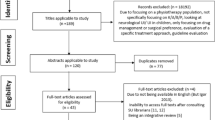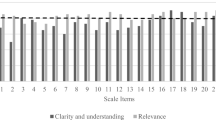Abstract
Introduction
Knowledge, attitude and practice (KAP) investigations lead to an understanding of what a particular population group knows, thinks and does in relation to a certain subject.
Methods
This systematic review was conducted to identify women’s KAP related to urinary incontinence (UI) described in the literature and the measurement/evaluation instruments used. A literature search, up to July 2017, was conducted in PUBMED, SCOPUS and BVS (Virtual Health Library) for articles dealing with women’s KAP related to UI that described the validation procedure of any data collection instrument. Articles that investigated exclusively male subjects, provider performance or academic teaching strategies were excluded. Relevant studies were analyzed and briefly summarized.
Results
Initially, 799 articles were retrieved. After applying the inclusion and exclusion criteria, 19 remained for reading and summarizing. There has been interest in identifying and evaluating some of the KAP elements related to UI since 1994, with a wide variety of validated instruments used. Knowledge was evaluated in 15 articles and all concluded that there was misinformation about UI in the populations studied. Seven articles studied the intention to seek healthcare for UI, among which only one evidenced an adequate attitude in more than 70% of the participants. All the articles that investigated practice revealed low rates of seeking care.
Conclusions
The KAP elements are influenced by specific questions in each of the studied populations, leading to unique results, which indicates the importance of investigations using standardized data collection instruments that have psychometric validity tested in the target populations.


Similar content being viewed by others
References
Haylen BT, de Ridder D, Freeman RM, et al. Int Urogynecol J. 2010;21:5. https://doi.org/10.1007/s00192-009-0976-9.
Abrams P, Cardozo L, Khoury S, Wein A. Incontinence. Tokyo: ICS/ICUD; 2016.
Ebbesen MH, Hunskaar S, Rortveit G, Hannestad YS. Prevalence, incidence and remission of urinary incontinence in women: longitudinal data from the Norwegian HUNT study (EPINCONT). BMC Urol. 2013;13(1):27. https://doi.org/10.1186/1471-2490-13-27.
Fritel X, Panjo H, Varnoux N, Ringa V. The individual determinants of care-seeking among middle-aged women reporting urinary incontinence: analysis of a 2273-woman cohort. Neurourol Urodyn. 2014;33:1116–22. https://doi.org/10.1002/nau.22461.
Perera J, Kirthinanda DS, Wijeratne S, Wickramarachchi TK. Descriptive cross sectional study on prevalence, perceptions, predisposing factors and health seeking behaviour of women with stress urinary incontinence. BMC Womens Health. 2014;14:78. https://doi.org/10.1186/1472-6874-14-78.
Badejoko OO, Bola-Oyebamiji S, Awowole IO, Salako AA, Ogunniyi SO. Urinary incontinence: prevalence, pattern, and opportunistic screening in Ile-Ife, Nigeria. Int Urogynecol J. 2016;27(2):269–73. https://doi.org/10.1007/s00192-015-2826-2.
Akkus Y, Pinar G. Evaluation of the prevalence, type, severity, and risk factors of urinary incontinence and its impact on quality of life among women in Turkey. Int Urogynecol J. 2016;27:887. https://doi.org/10.1007/s00192-015-2904-5.
Siddiqui NY, Levin PJ, Phadtare A, Pietrobon R, Ammarell N. Perceptions about female urinary incontinence: a systematic review. Int Urogynecol J. 2014;25(7):863–71. https://doi.org/10.1007/s00192-013-2276-7.
Seshan V, Muliira JK. Self-reported urinary incontinence and factors associated with symptom severity in community dwelling adult women: implications for women’s health promotion. BMC Womens Health. 2013;13(1):16. https://doi.org/10.1186/1472-6874-13-16.
Branch LG, Walker LA, Wetle TT, DuBeau CE, Resnick NM. Urinary incontinence knowledge among community-dwelling people 65 years of age and older. J Am Geriatr Soc. 1994;42(12):1257–61. https://doi.org/10.1111/j.1532-5415.1994.tb06507.x.
Guillen Lopez O, Llanos Zavalaga F, Lecca Garcia L. Conocimientos sobre incontinencia urinaria en pacientes hospitalizados. Rev Med Herediana. 2003;14(4):186–94. http://www.scielo.org.pe/scielo.php?script=sci_arttext&pid=S1018-130X2003000400007. Accessed 26 Jan 2018
Saleh N, Bener A, Khenyab N, Al-Mansori Z, Al Muraikhi A. Prevalence, awareness and determinants of health care-seeking behaviour for urinary incontinence in Qatari women: a neglected problem? Maturitas. 2005;50(1):58–65. https://doi.org/10.1016/j.maturitas.2004.04.003.
Liao YM, Dougherty MC, Liou YS, Tseng J. Pelvic floor muscle training effect on urinary incontinence knowledge, attitudes, and severity: an experimental study. Int J Nurs Stud. 2006;43(1):29–37. https://doi.org/10.1016/j.ijnurstu.2005.01.004.
Dunivan GC, Komesu YM, Cichowski SB, Lowery C, Anger JT, Rogers RG. Elder American Indian women’s knowledge of pelvic floor disorders and barriers to seeking care. Female Pelvic Med Reconstr Surg. 2015;21(1):34–8. https://doi.org/10.1097/spv.0000000000000103.
Mandimika CL, William MURK, Mcpencow AM, AeuMuro LAKE, Miller D, Connell KA, et al. Racial disparities in knowledge of pelvic floor disorders among community-dwelling women. Female Pelvic Med Reconstr Surg. 2015;21(5):287. https://doi.org/10.1097/SPV.0000000000000182.
O’Donnell M, Lose G, Sykes D, Voss S, Hunskaar S. Help-seeking behaviour and associated factors among women with urinary incontinence in France, Germany, Spain and the United Kingdom. Eur Urol. 2005;47(3):385–92. https://doi.org/10.1016/j.eururo.2004.09.014.
Wang C, Li J, Wan X, Wang X, Kane RL, Wang K. Effects of stigma on Chinese women’s attitudes towards seeking treatment for urinary incontinence. J Clin Nurs. 2015;24(7–8):1112–21. https://doi.org/10.1111/jocn.12729.
De Gagne JC, So A, Wu B, Palmer MH, McConnell ES. The effect of a urinary incontinence self-management program for older women in south Korea: a pilot study. Int J Nurs Sci. 2015;2(1):39–46. https://doi.org/10.1016/j.ijnss.2015.01.002.
Bano R, AlShammari E, Fatima SB, Al-Shammari NA. A comparative study of knowledge, attitude, practice of nutrition and non-nutrition student towards a balanced diet in Hail University. J Nurs Health Sci. 2013;2(1):29–36. https://pdfs.semanticscholar.org/2a71/bd6aa915a6bfe10a16d7291b8e19d3a7ffbb.pdf. Accessed 26 Jan 2018
Geoffrion R, Robert M, Ross S, van Heerden D, Neustaedter G, Tang S, et al. Evaluating patient learning after an educational program for women with incontinence and pelvic organ prolapse. Int Urogynecol J Pelvic Floor Dysfunct. 2009;20(10):1243–52. https://doi.org/10.1007/s00192-009-0919-5.
Zhang N, He Y, Wang J, Zhang Y, Ding J, Hua KQ. Effects of a new community-based reproductive health intervention on knowledge of and attitudes and behaviors toward stress urinary incontinence among young women in Shanghai: a cluster-randomized controlled trial. Int Urogynecol J. 2016;27(4):545–53. https://link.springer.com/article/10.1007/s00192-015-2851-1. Accessed 26 Jan 2018
Yuan H, Williams BA. Knowledge of urinary incontinence among Chinese community nurses and community-dwelling older people. Health Soc Care Community. 2010;18(1):82–90. https://doi.org/10.1111/j.1365-2524.2009.00876.x.
Kim JS, Lee EH, Park HC. Urinary incontinence: prevalence and knowledge among community-dwelling Korean women aged 55 and over. J Korean Acad Nurs. 2004;34(4):609–16. http://www.dbpia.co.kr/Journal/ArticleDetail/NODE02027081. Accessed 26 Jan 2018
Bush TA, Castellucci DT, Phillips C. Exploring women's beliefs regarding urinary incontinence. Urol Nurs. 2001;21(3):211. https://search.proquest.com/openview/30f5814b0d15ce4dcc2090abf71950a3/1?pq-origsite=gscholar&cbl=29865. Accessed 26 Jan 2018
Keller SL. Urinary incontinence: occurrence, knowledge, and attitudes among women aged 55 and older in a rural Midwestern setting. J WOCN. 1999;26(1):30–8. https://doi.org/10.1016/S1071-5754(99)90008-6.
Kang Y, Crogan NL. Social and cultural construction of urinary incontinence among Korean American elderly women. Geriatr Nurs. 2008;29(2):105–11. https://doi.org/10.1016/j.gerinurse.2008.01.002.
Yuan HB, Williams BA, Liu M. Attitudes toward urinary incontinence among community nurses and community-dwelling older people. J Wound Ostomy Cont Nurs. 2011;38(2):184–9. https://doi.org/10.1097/WON.0b013e31820af394.
El-Azab AS, Shaaban OM. Measuring the barriers against seeking consultation for urinary incontinence among middle eastern women. BMC Womens Health. 2010;10:3. https://doi.org/10.1186/1472-6874-10-3.
Shah AD, Massagli MP, Kohli N, Rajan SS, Braaten KP, Hoyte L. A reliable, valid instrument to assess patient knowledge about urinary incontinence and pelvic organ prolapse. Int Urogynecol J. 2008;19(9):1283. https://doi.org/10.1007/s00192-008-0631-x.
Norton JM, Dodson JL, Newman DK, Rogers RG, Fairman AD, Coons HL, et al. Nonbiologic factors that impact management in women with urinary incontinence: review of the literature and findings from a National Institute of Diabetes and Digestive and Kidney Diseases workshop. Int Urogynecol J. 2017;28(9):1295–307. https://doi.org/10.1007/s00192-017-3400-x.
McLellan M, Melick C, Alten B, Young J, Hoehn M. Patients’ knowledge of potential pelvic floor changes associated with pregnancy and delivery. Int Urogynecol J. 2005;17:22–6. https://doi.org/10.1007/s00192-005-1325-2.
Fine P, Burgio K, Borello-France D, Richter H, Whitehead W, Weber A, et al. Teaching and practicing of pelvic floor muscle exercises in primiparous women during pregnancy and the postpartum period. Am J Obstet Gynecol. 2007;197(1):107–e1. https://doi.org/10.1016/j.ajog.2007.02.052.
Willis-Gray MG, Sandoval JS, Maynor J, Bosworth HB, Siddiqui NY. Barriers to urinary incontinence care seeking in white, black, and Latina women. Female Pelvic Med Reconstr Surg. 2015;21(2):83–6. https://doi.org/10.1097/spv.0000000000000100.
Mallett VT, Jezari AM, Carrillo T, Sanchez S, Mulla ZD. Barriers to seeking care for urinary incontinence in Mexican American women. Int Urogynecol J. 2018;29(2):235–41. https://doi.org/10.1007/s00192-017-3420-6.
Author information
Authors and Affiliations
Corresponding author
Ethics declarations
Conflicts of interest
None.
Rights and permissions
About this article
Cite this article
Vasconcelos, C.T.M., Firmiano, M.L.V., Oriá, M.O.B. et al. Women’s knowledge, attitude and practice related to urinary incontinence: systematic review. Int Urogynecol J 30, 171–180 (2019). https://doi.org/10.1007/s00192-018-3759-3
Received:
Accepted:
Published:
Issue Date:
DOI: https://doi.org/10.1007/s00192-018-3759-3




